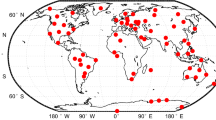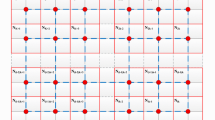Abstract
Atmospheric pressure, temperature and zenith wet delay (ZWD) are important meteorological parameters for GNSS (Global Navigation Satellite Systems) data processing and GNSS meteorology. Due to the fact that not all GNSS stations are physically equipped with meteorological sensors, empirical models are widely used for the prediction of the atmospheric pressure (which can be used for the calculation of zenith hydrostatic delay (ZHD)), temperature and ZWD. However, if the reference height significantly differs from the height of the user site, the quality of the predicted meteorological parameters may be poor due to the height difference between the user site and the reference level. To address these issues, a voxel-based atmospheric pressure and temperature model, named PVoxel, was developed to improve the accuracy in the determination of both atmospheric pressures and temperatures. Ten-year ERA5 monthly mean reanalysis data were used for the development of PVoxel, and each monthly mean atmospheric pressure and temperature at each of the four selected reference heights (0, 4, 10 and 15 km) and the ZWD with its vertical decay parameter at 0 and 4 km over all globally distributed grid points (horizontal resolution 1° × 1°), i.e., at the nodes of the 3D voxels, were determined. Then, the characteristics of the annual and semi-annual variations of these parameters in the temporal domain for each node were modeled. The PVoxel model can be used to predict atmospheric pressure, temperature and ZWD at any geographic location and time. The model was evaluated by comparing the model-predicted results for the sites of all globally distributed radiosonde stations against the corresponding radiosonde data in 2019. The results showed that the atmospheric pressure and temperature predicted by PVoxel were improved significantly compared to four advanced publicly available empirical models, i.e., UNB3m, GPT3, IGPT and GTrop, especially at high altitudes. The significant improvement in the accuracy of the new model is promising for better determination of ZHD and GNSS-based applications.






Similar content being viewed by others
Data availability
ERA5 monthly mean reanalysis data: https://doi.org/10.24381/cds.6860a573. Radiosonde data: ftp://ftp.ncdc.noaa.gov/pub/data/igra/. The PVoxel model developed in this contribution is available at: https://github.com/PengSun-CUMT/PVoxel
References
Askne J, Nordius H (1987) Estimation of tropospheric delay for microwaves from surface weather data. Radio Sci 22(3):379–386. https://doi.org/10.1029/RS022i003p00379
Bianchi CE, Mendoza LPO, Fernández LI, Natali MP, Meza AM, Moirano JF (2016) Multi-year GNSS monitoring of atmospheric IWV over Central and South America for climate studies. Ann Geophys 34(7):623–639. https://doi.org/10.5194/angeo-34-623-2016
Boehm J, Werl B, Schuh H (2006) Troposphere mapping functions for GPS and very long baseline interferometry from European centre for medium-range weather forecasts operational analysis data. J Geophys Res Solid Earth 111(B2):B02406. https://doi.org/10.1029/2005JB003629
Boehm J, Heinkelmann R, Schuh H (2007) Short note: a global model of pressure and temperature for geodetic applications. J Geod 81(10):679–683. https://doi.org/10.1007/s00190-007-0135-3
Böhm J, Möller G, Schindelegger M, Pain G, Weber R (2015) Development of an improved empirical model for slant delays in the troposphere (GPT2w). GPS Solut 19(3):433–441. https://doi.org/10.1007/s10291-014-0403-7
Davis JL, Herring TA, Shapiro II, Rogers AEE, Elgered G (1985) Geodesy by radio interferometry: effects of atmospheric modeling errors on estimates of baseline length. Radio Sci 20(6):1593–1607. https://doi.org/10.1029/RS020i006p01593
Dousa J, Elias M (2014) An improved model for calculating tropospheric wet delay. Geophys Res Lett 41(12):4389–4397. https://doi.org/10.1002/2014GL060271
He C, Wu S, Wang X, Hu A, Wang Q, Zhang K (2017) A new voxel-based model for the determination of atmospheric weighted mean temperature in GPS atmospheric sounding. Atmos Meas Tech 10(6):2045–2060. https://doi.org/10.5194/amt-10-2045-2017
Kouba J (2008) Implementation and testing of the gridded Vienna mapping function 1 (VMF1). J Geod 82(4–5):193–205. https://doi.org/10.1007/s00190-007-0170-0
Lagler K, Schindelegger M, Böhm J, Krásná H, Nilsson T (2013) GPT2: empirical slant delay model for radio space geodetic techniques. Geophys Res Lett 40(6):1069–1073. https://doi.org/10.1002/grl.50288
Landskron D, Böhm J (2018) VMF3/GPT3: refined discrete and empirical troposphere mapping functions. J Geod 92(4):349–360. https://doi.org/10.1007/s00190-017-1066-2
Leandro R, Santos M, Langley RB (2006) UNB neutral atmosphere models: development and performance. Institute of Navigation, Monterey, California, USA, pp 564–573
Li T, Wang L, Chen R, Fu W, Xu B, Jiang P, Liu J, Zhou H, Han Y (2021) Refining the empirical global pressure and temperature model with the ERA5 reanalysis and radiosonde data. J Geod 95(3):31. https://doi.org/10.1007/s00190-021-01478-9
Mao J, Wang Q, Liang Y, Cui T (2021) A new simplified zenith tropospheric delay model for real-time GNSS applications. GPS Solut 25(2):43. https://doi.org/10.1007/s10291-021-01092-4
Mateus P, Catalão J, Mendes VB, Nico G (2020) An ERA5-based hourly global pressure and temperature (HGPT) model. Remote Sens 12(7):1098. https://doi.org/10.3390/rs12071098
Nafisi V, Urquhart L, Santos MC, Nievinski FG, Bohm J, Wijaya DD, Schuh H, Ardalan AA, Hobiger T, Ichikawa R, Zus F, Wickert J, Gegout P (2012) Comparison of ray-tracing packages for troposphere delays. IEEE Trans Geosci Remote Sens 50(2):469–481. https://doi.org/10.1109/TGRS.2011.2160952
Rüeger JM (2002) Refractive index formulae for radio waves. In: Proceedings of the FIG XXII International Congress, Washington, DC, USA.
Saastamoinen J (1972) Atmospheric correction for the troposphere and stratosphere in radio ranging satellites. In: The use of artificial satellites for Geodesy. Am Geophys Union (AGU), pp 247–251
Schüler T (2014) The TropGrid2 standard tropospheric correction model. GPS Solut 18(1):123–131. https://doi.org/10.1007/s10291-013-0316-x
Sun Z, Zhang B, Yao Y (2019) A global model for estimating tropospheric delay and weighted mean temperature developed with atmospheric reanalysis data from 1979 to 2017. Remote Sens 11(16):1893. https://doi.org/10.3390/rs11161893
Sun P, Wu S, Zhang K, Wan M, Wang R (2021) A new global grid-based weighted mean temperature model considering vertical nonlinear variation. Atmos Meas Tech 14(3):2529–2542. https://doi.org/10.5194/amt-14-2529-2021
Teke K, Böhm J, Nilsson T, Schuh H, Steigenberger P, Dach R, Heinkelmann R, Willis P, Haas R, García-Espada S, Hobiger T, Ichikawa R, Shimizu S (2011) Multi-technique comparison of troposphere zenith delays and gradients during CONT08. J Geod 85(7):395. https://doi.org/10.1007/s00190-010-0434-y
Tregoning P, Herring TA (2006) Impact of a priori zenith hydrostatic delay errors on GPS estimates of station heights and zenith total delays. Geophys Res Lett 33(23):L23303. https://doi.org/10.1029/2006GL027706
Wang X, Zhang K, Wu S, He C, Cheng Y, Li X (2017) Determination of zenith hydrostatic delay and its impact on GNSS-derived integrated water vapor. Atmos Meas Tech 10(8):2807–2820. https://doi.org/10.5194/amt-10-2807-2017
Wilgan K, Rohm W, Bosy J (2015) Multi-observation meteorological and GNSS data comparison with numerical weather prediction model. Atmos Res 156:29–42. https://doi.org/10.1016/j.atmosres.2014.12.011
Xu C, Yao Y, Shi J, Zhang Q, Peng W (2020) Development of global tropospheric empirical correction model with high temporal resolution. Remote Sens 12(4):721. https://doi.org/10.3390/rs12040721
Yang F, Meng X, Guo J, Shi J, An X, He Q, Zhou L (2020) The influence of different modelling factors on global temperature and pressure models and their performance in different zenith hydrostatic delay (ZHD) models. Remote Sens 12(1):35. https://doi.org/10.3390/rs12010035
Yao Y, Xu C, Shi J, Cao N, Zhang B, Yang J (2015) ITG: a new global GNSS tropospheric correction model. Sci Rep 5(1):10273. https://doi.org/10.1038/srep10273
Zhang W, Lou Y, Huang J, Liu W (2018) A refined regional empirical pressure and temperature model over China. Adv Space Res 62(5):1065–1074. https://doi.org/10.1016/j.asr.2018.06.021
Acknowledgements
This work was funded by the National Natural Science Foundation of China (Grant No. 42274021, 41730109, 41874040). The authors would like to acknowledge the support of the Construction Program of Space-Air-Ground-Well Cooperative Awareness Spatial Information Project (Grant No. B20046), the Independent Innovation Project of “Double-First Class” Construction (Grant No. 2022ZZCX06), and 2022 Jiangsu Provincial Science and Technology Initiative-Special Fund for International Science and Technology Cooperation (Grant No. BZ2022018). We would like to thank ECMWF and IGRA for providing ERA5 reanalysis data and radiosonde profiles, respectively. We thank the anonymous reviewers for their constructive comments and suggestions.
Author information
Authors and Affiliations
Corresponding author
Additional information
Publisher's Note
Springer Nature remains neutral with regard to jurisdictional claims in published maps and institutional affiliations.
Rights and permissions
Springer Nature or its licensor (e.g. a society or other partner) holds exclusive rights to this article under a publishing agreement with the author(s) or other rightsholder(s); author self-archiving of the accepted manuscript version of this article is solely governed by the terms of such publishing agreement and applicable law.
About this article
Cite this article
Sun, P., Zhang, K., Wu, S. et al. An investigation of a voxel-based atmospheric pressure and temperature model. GPS Solut 27, 56 (2023). https://doi.org/10.1007/s10291-022-01390-5
Received:
Accepted:
Published:
DOI: https://doi.org/10.1007/s10291-022-01390-5




